tow bar MITSUBISHI SHOGUN 2003 Owner's Manual (in English)
[x] Cancel search | Manufacturer: MITSUBISHI, Model Year: 2003, Model line: SHOGUN, Model: MITSUBISHI SHOGUN 2003Pages: 392, PDF Size: 14.34 MB
Page 23 of 392
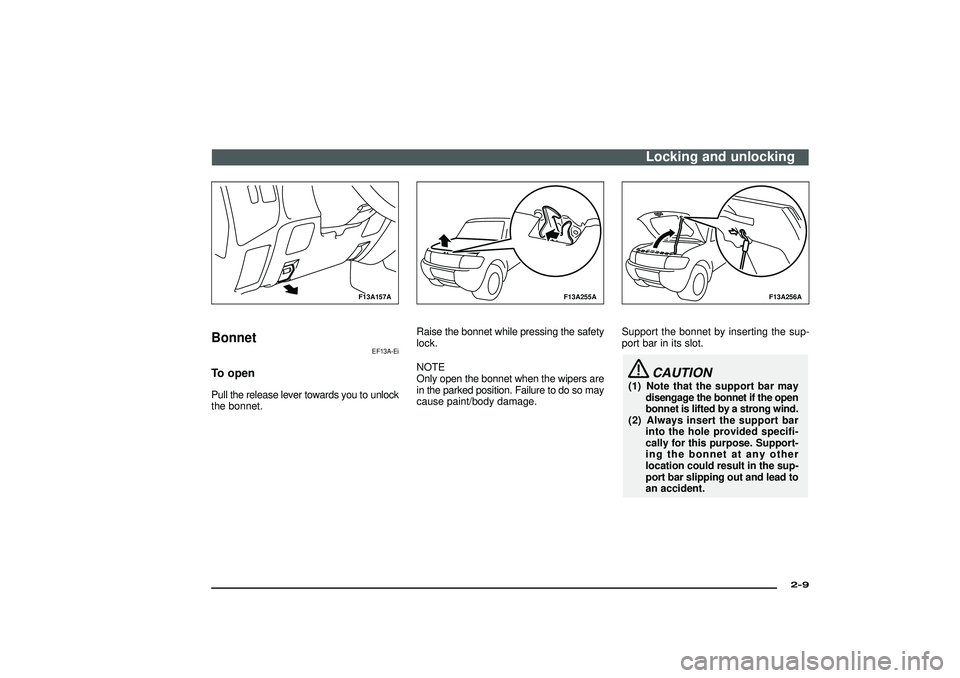
F13A157A
Bonnet
EF13A-Ei
To openPull the release lever towards you to unlock
the bonnet.
F13A255A
Raise the bonnet while pressing the safety
lock.
NOTE
Only open the bonnet when the wipers are
in the parked position. Failure to do so may
cause paint/body damage.
F13A256A
Support the bonnet by inserting the sup-
port bar in its slot.
CAUTION
(1) Note that the support bar may
disengage the bonnet if the open
bonnet is lifted by a strong wind.
(2) Always insert the support bar
into the hole provided specifi-
cally for this purpose. Support-
ing the bonnet at any other
location could result in the sup-
port bar slipping out and lead to
an accident.
Locking and unlocking
2-9
Div:
Out put date:
Page 166 of 392
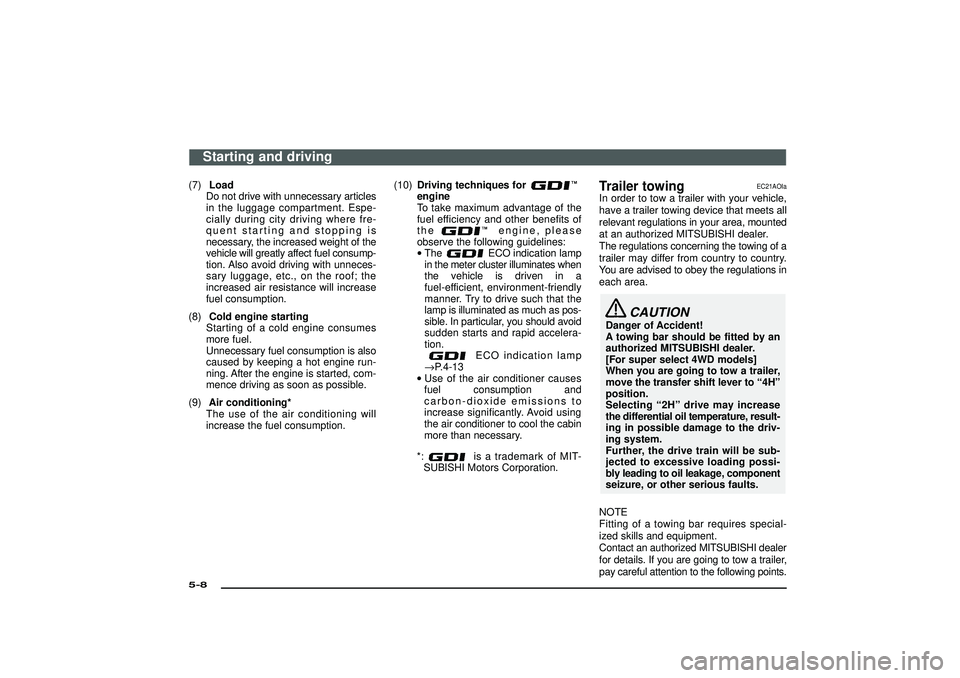
(7)Load
Do not drive with unnecessary articles
in the luggage compartment. Espe-
cially during city driving where fre-
quent starting and stopping is
necessary, the increased weight of the
vehicle will greatly affect fuel consump-
tion. Also avoid driving with unneces-
sary luggage, etc., on the roof; the
increased air resistance will increase
fuel consumption.
(8)Cold engine starting
Starting of a cold engine consumes
more fuel.
Unnecessary fuel consumption is also
caused by keeping a hot engine run-
ning. After the engine is started, com-
mence driving as soon as possible.
(9)Air conditioning*
The use of the air conditioning will
increase the fuel consumption.(10)Driving techniques for
engine
To take maximum advantage of the
fuel efficiency and other benefits of
the
engine, please
observe the following guidelines:
•TheECO indication lamp
in the meter cluster illuminates when
the vehicle is driven in a
fuel-efficient, environment-friendly
manner. Try to drive such that the
lamp is illuminated as much as pos-
sible. In particular, you should avoid
sudden starts and rapid accelera-
tion.
ECO indication lamp
→P.4-13
•Use of the air conditioner causes
fuel consumption and
carbon-dioxide emissions to
increase significantly. Avoid using
the air conditioner to cool the cabin
more than necessary.
*:is a trademark of MIT-
SUBISHI Motors Corporation.
Trailer towing
EC21AOIa
In order to tow a trailer with your vehicle,
have a trailer towing device that meets all
relevant regulations in your area, mounted
at an authorized MITSUBISHI dealer.
The regulations concerning the towing of a
trailer may differ from country to country.
You are advised to obey the regulations in
each area.
CAUTION
Danger of Accident!
A towing bar should be fitted by an
authorized MITSUBISHI dealer.
[For super select 4WD models]
When you are going to tow a trailer,
move the transfer shift lever to“4H”
position.
Selecting“2H”drive may increase
the differential oil temperature, result-
ing in possible damage to the driv-
ing system.
Further, the drive train will be sub-
jected to excessive loading possi-
bly leading to oil leakage, component
seizure, or other serious faults.
NOTE
Fitting of a towing bar requires special-
ized skills and equipment.
Contact an authorized MITSUBISHI dealer
for details. If you are going to tow a trailer,
pay careful attention to the following points.
Starting and driving
5-8Div:
Out put date:
Page 167 of 392
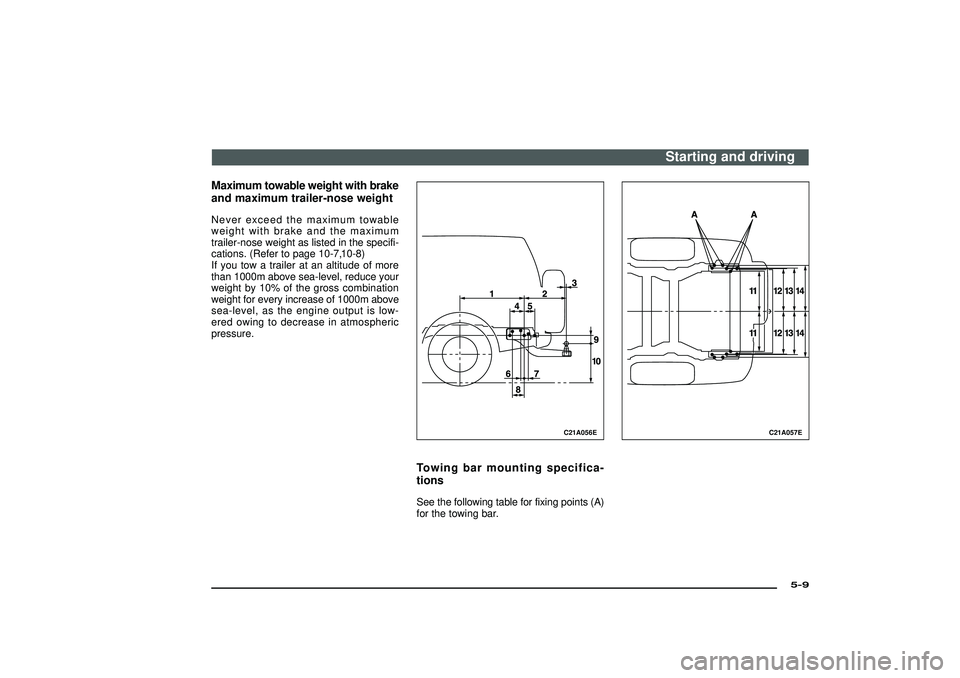
Maximum towable weight with brake
and maximum trailer-nose weightNever exceed the maximum towable
weight with brake and the maximum
trailer-nose weight as listed in the specifi-
cations. (Refer to page 10-7,10-8)
If you tow a trailer at an altitude of more
than 1000m above sea-level, reduce your
weight by 10% of the gross combination
weight for every increase of 1000m above
sea-level, as the engine output is low-
ered owing to decrease in atmospheric
pressure.
C21A056E
Towing bar mounting specifica-
tionsSee the following table for fixing points (A)
for the towing bar.
C21A057E
Starting and driving
5-9
Div:
Out put date:
Page 168 of 392
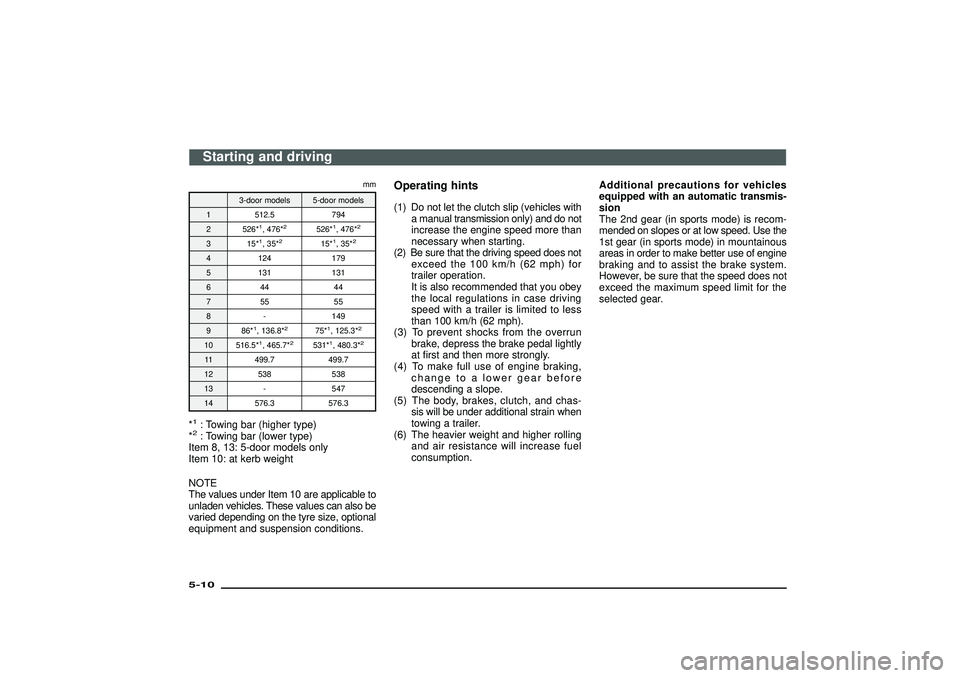
mm
3-door models 5-door models
1 512.5 794
2 526*
1, 476*
2
526*
1, 476*
2
3 15*
1, 35*
2
15*
1, 35*
2
4 124 179
5 131 131
644 44
755 55
8 - 149
9 86*
1, 136.8*
2
75*
1, 125.3*
2
10 516.5*
1, 465.7*
2
531*
1, 480.3*
2
11 499.7 499.7
12 538 538
13 - 547
14 576.3 576.3
*1: Towing bar (higher type)
*2: Towing bar (lower type)
Item 8, 13: 5-door models only
Item 10: at kerb weight
NOTE
The values under Item 10 are applicable to
unladen vehicles. These values can also be
varied depending on the tyre size, optional
equipment and suspension conditions.
Operating hints(1) Do not let the clutch slip (vehicles with
a manual transmission only) and do not
increase the engine speed more than
necessary when starting.
(2) Be sure that the driving speed does not
exceed the 100 km/h (62 mph) for
trailer operation.
It is also recommended that you obey
the local regulations in case driving
speed with a trailer is limited to less
than 100 km/h (62 mph).
(3) To prevent shocks from the overrun
brake, depress the brake pedal lightly
at first and then more strongly.
(4) To make full use of engine braking,
change to a lower gear before
descending a slope.
(5) The body, brakes, clutch, and chas-
sis will be under additional strain when
towing a trailer.
(6) The heavier weight and higher rolling
and air resistance will increase fuel
consumption.Additional precautions for vehicles
equipped with an automatic transmis-
sion
The 2nd gear (in sports mode) is recom-
mended on slopes or at low speed. Use the
1st gear (in sports mode) in mountainous
areas in order to make better use of engine
braking and to assist the brake system.
However, be sure that the speed does not
exceed the maximum speed limit for the
selected gear.
Starting and driving
5-10Div:
Out put date:
Page 356 of 392
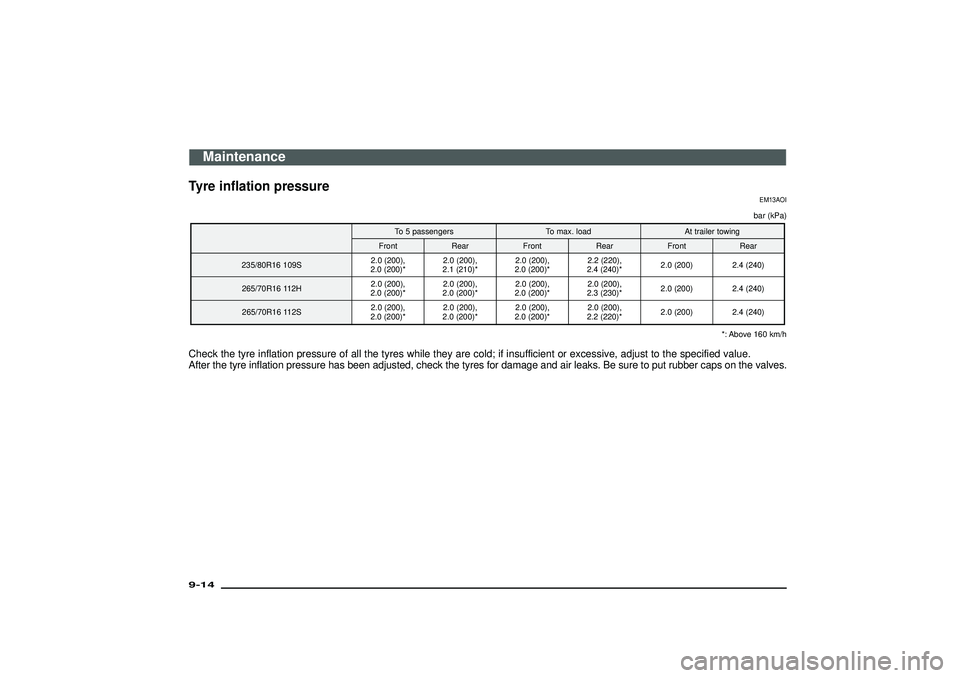
Tyre inflation pressure
EM13AOIbar (kPa)
To 5 passengers To max. load At trailer towing
Front Rear Front Rear Front Rear
235/80R16 109S2.0 (200),
2.0 (200)*2.0 (200),
2.1 (210)*2.0 (200),
2.0 (200)*2.2 (220),
2.4 (240)*2.0 (200) 2.4 (240)
265/70R16 112H2.0 (200),
2.0 (200)*2.0 (200),
2.0 (200)*2.0 (200),
2.0 (200)*2.0 (200),
2.3 (230)*2.0 (200) 2.4 (240)
265/70R16 112S2.0 (200),
2.0 (200)*2.0 (200),
2.0 (200)*2.0 (200),
2.0 (200)*2.0 (200),
2.2 (220)*2.0 (200) 2.4 (240)
*: Above 160 km/h
Check the tyre inflation pressure of all the tyres while they are cold; if insufficient or excessive, adjust to the specified value.
After the tyre inflation pressure has been adjusted, check the tyres for damage and air leaks. Be sure to put rubber caps on the valves.
Maintenance
9-14Div:
Out put date: